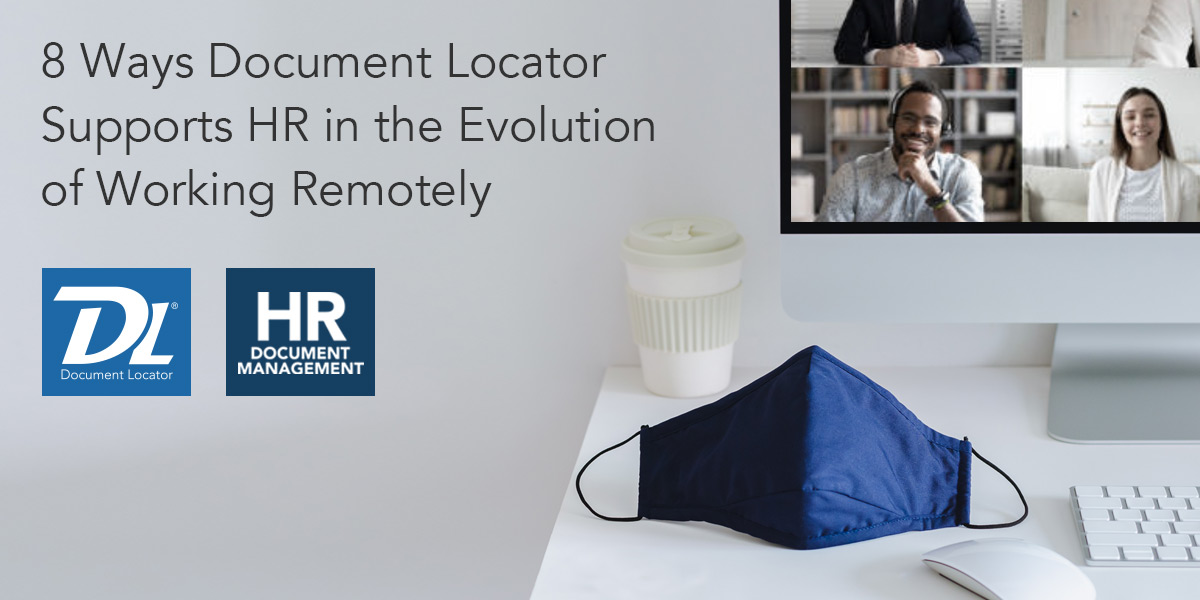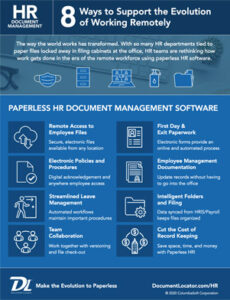With the arrival of the age of COVID, the way the world works has transformed. This workplace transformation has touched every aspect of the business and is particularly visible in the human resources arena. With so many HR departments tied to paper files filled with confidential employee information locked away in file cabinets at the office, HR teams are rethinking how work can be accomplished in the era of the remote workforce – including for HR staff themselves.
As businesses look to reduce risk by only having essential employees return to work, this can often draw a question mark for those who work in HR. While the human interaction work of the human resource department can be transitioned to Zoom, being tied to paper processes can make getting work done remotely near impossible. Do HR staff need to be considered essential and return to working in the office, or is there a way to reduce risk and transition to a model that supports remote HR work?
To solve this problem, more and more companies are turning to electronic HR document management software to usher in the era of the paperless office. As we enter a new normal where working from home becomes the norm, companies are re-engineering their paper-based processes and are finding sustainable solutions to help HR thrive and not simply get by. Let’s explore 8 ways Document Locator can keep HR working, even when we are working from home.
1.Remote Access to Employee Files
The clear benefit of utilizing Document Locator is enabling access to employee files in a way that is secure. By having employee documents stored electronically, either in the cloud or on a server accessible via VPN, HR staff no longer need to go into the office to access the physical documents needed to get their work done. This also ensures that no staff are tempted to bring home confidential paper documents in order to get work done, putting employee information and their documents at risk.
Additionally, by having an electronic file system, the employee file can be accessed by multiple people within HR, and not just the person who holds the file. No more having to worry about hunting down a file or wondering if a document has been stored in the correct place. Everything is text searchable, files have security applied so only the authorized staff have access, and you can quickly view any document’s history.
2. Automation of Policies and Procedures Acknowledgements
Even before COVID-19, many employers were updating their policies and procedures more frequently due to an increase in employment laws and regulations. With the new Coronavirus dynamic, there is an even greater emphasis on updating HR policies and procedures, whether they be about telecommuting, appropriate workplace conduct, leave policies, or safety and health procedures. Without a document management system, the process of collecting wet signatures on each new policy can be an inefficient burden on HR. Document Locator’s Read and Acknowledge functionality makes it easy to quickly send out a copy of the new policy to all staff, have them acknowledge via a web browser, and then automatically file away the acknowledged document in the employee’s folder, without HR having to send a single email. The added features of automated reminders and a completion status report makes it easy to ensure compliance.
3. Support in Leave Management
Unfortunately, with many reporting on lengthy battles with COVID-19, not to mention the toll that current stressors can take on physical and mental health, it is understandable that companies may see an uptick in leave requests. With Document Locator, companies can build out customized workflows that can be initiated by the manager, ensure that everyone who needs to be informed (payroll, benefits, etc.) are integrated into the process, and provide a way to track actions taken. Notifications can be automatically sent, whether they are notices of rights to the employee, or task reminders to HR staff to periodically check in. The leave process can require a lot of steps to manage, and with Document Locator’s workflow tools, automating the process has never been easier.
4. Enabling Collaboration
The consensus is that the surge in remote working will continue long after Coronavirus is in the rear-view mirror. With that in mind, it is crucial to find effective ways for employees to work collaboratively. The old model of sending documents back and forth via email (or worse, via paper) is a drain on efficiency, never knowing if the file you have is the latest one, or if the work you are doing is at odds with someone doing similar work on the same document. By utilizing Document Locator’s check-out functionality, only one person is able to make changes to a document at a time – with clear indicators as to who has it checked out and since when. Version history allows you to look through various iterations of the document in case you ever need to roll back or recapture something from a few versions prior. And custom workflows can have you routing documents from one stage of work to the next, finalizing the document into PDF form if desired, and filing away to its final destination.
A great example of this type of process is Document Locator’s Job Description workflow, which can check out a job description to the manager for updating; route through to HR for review, adjustments, and approval; and then finalize the document into a PDF version in a public folder for all employees to access. Working with a document management system is more than simply having electronic files, it is an opportunity to rethink your processes entirely.
5. First Day & Exit Paperwork
Arguably the most paper-heavy parts of the employee lifecycle are the day the employee starts and the day they leave. There are forms to fill out, policies to acknowledge, information to provide, and documents to collect. With Document Locator, remote employee onboarding becomes a very real possibility. With the Perfect Forms add on, employees can complete their forms at home through a web interface. The forms are then routed through HR for any additional information and are then automatically filed away into the employee folder. Similar processes can be enabled for the exit process, including automation of notices for those who are involved in the process to track their work tasks.
6. Employee Management Documentation
Even when working from home, managing and documenting employee performance still needs to happen, certifications and licenses still need to be kept up to date, and keeping track of required and additional trainings still needs to be done. Without a document management system these various documents can end up in a variety of places – from a manager’s personal file cabinet to an employee’s refrigerator – and not end up where they are needed: in the employee file.
In traditional HR filing, managers usually do not have access to the file unless upon request, whether due to confidentiality concerns or simply because there is just the one file to keep track of. With Document Locator’s security functionality, the manager can be given limited access to a sub-folder within the employee’s folder, allowing them to keep all performance documentation together in one place, making it easy for HR staff to stay on the same page with the manager. A blind drop off folder can also be accessed by the employee, who can drop off any certification, training records, or licenses and then have those documents automatically moved into the employee folder, with notifications sent to HR or the manager if desired.
7. Folders Can Manage Themselves
HR no longer needs to be in the office to create new folders for employees, move those folders to the term cabinets, and purge those files once the record has hit its retention limit. Document Locator integrates with your HRIS or Payroll system to notice when a new employee has been added and instantly creates the entire folder structure for that employee. When the employee exits, Document Locator gently transitions that employee to the Inactive folder set. And finally, depending on your record retention requirements, Document Locator will serve up folders for review by a record manager, or can simply delete them so they don’t have to even be thought about again.
8. Recoup Money
Finally, with the uncertainty of the economy, HR departments are looking for ways to cut costs without having to cut employees. For those that are still operating in a paper world, transitioning to electronic can be a substantial cost savings not only in square feet, but also in time saved managing paper. Document Locator’s Software ROI Calculator can help you discover how much money your company will be able to save by going paperless.
Make the Evolution to Paperless
Times of change, while stressful, can offer opportunities to evolve. It is through the chaos and challenge that businesses are given the chance to stop and re-evaluate business practices, and through that reflection is the possibility to become stronger. The human resource function has been reinventing itself over the last 100 years, from personnel to people operations, from transactional to transformational. Now is the moment to move into the future, and Document Locator’s HR document management technology is here to be a part of that journey.
Read our HR Remote Work Fact Sheet








